ATI RN Community Health Nursing Study Guide Latest Updated 2022
Document Content and Description Below
ATI RN Community Health Nursing Study Guide Latest Updated 2022 Systems thinking Correct Answer-Studies how an individual, or unit, interacts with other organizations or systems Upstream thinking ... Correct Answer-Is used to focus on interventions that promote health or prevent illness, as opposed to medical treatment models that focus on care after an individual becomes ill What provides the basis for care of the community and family? Correct Answer-nursing theories What are the community health nursing theories? (4) Correct Answer--Nightingale's Environmental Theory -Health Belief Model -Milio's framework for prevention -Pender's Health Promotion Model What theory emphasizes preventive care? Correct Answer-Nightingale's Environmental Nightingale's Environmental Theory Correct Answer--Highlights the relationship between an individual's environment and health-Depicts health as a continuum -Emphasizes preventive care Health Belief Model Correct Answer--Purpose is to predict health behaviors -Emphasizes change at the individual level -Assumes that the preventive health behaviors are taken primarily for the purpose of avoiding disease The health belief model describes the likelihood of taking an action to avoid disease based on: (4) Correct Answer--perceived susceptibility, seriousness, and threat of disease -modifying factors -cues to action -perceived benefits minus perceived barriers to taking action Which model is similar to the health belief, but does not consider health risk factor as a factor that promote change? Correct Answer-Pender's What theory COMPLEMENTS the health belief model? Correct Answer-Milio's framework for prevention Milio's Framework for Prevention Correct Answer--Emphasizes change at the community level -Identifies relationship between health deficits and availability of health-promoting resourcesWhich theory theorizes that behavior change within a large group could ultimately lead to social change? Correct Answer-Milio's framework Pender's Health Promotion Model Correct Answer--Does not consider health risk as a factor that provokes change -Examines factors that affect individuals actions like: personal factors, feelings, benefits, barriers, attitudes of others, and abilities Determinants of Health Correct Answer-Factors that influence that client's health. --> nutrition, stress, education, environment, finances, and social status Health Indicators Correct Answer-Describe the health status of a *community* and serve as targets for the improvement of a community's health --> mortality rates, disease prevalence, levels of physical activity, obesity, tobacco, or other substance use Community Correct Answer--A group of people and institutions that share geographic, civic, and/or social parameters -The "community is the client" in community health nursingGoals of Community Health Nursing Correct Answer-Promote, preserve, and maintain the health of populations by the delivery of health services to individuals, families, and groups in order to influence "community health" What type of setting is care usually delivered in the community? Correct Answer-setting that is part of the clients environment -->>home, school, work Public Health Nursing Correct Answer--It is population-focused, and involves a combination of nursing knowledge along with social and public health sciences -GOAL: promote health and preventing disease PHN: Assessment Correct Answer--Using systematic methods to monitor the health of a population -->Monitor health status to identify community health problems -->Diagnose and investigate health problems/hazards in the community PHN: Policy Development Correct Answer-Developing laws and practices to promote the health of a population based on scientific evidencePHN: Assurance Correct Answer-Making sure adequate health care personnel and services are accessible, especially to those who might not normally have them Population-focused Nursing Correct Answer--Includes assessing to determine needs, intervening to protect and promote health, and preventing disease within a specific population Key Principles of PHN: Correct Answer--Emphasize primary prevention -Work to achieve the greatest good for the largest number of individuals -Recognize that the client is a partner in health -Use resources wisely to promote the best outcomes What are the principles that guide community health nursing? Correct Answer--ethics -advocacy -EBP -quality -professional collaboration and communication Ethics Correct Answer-Preventing harm, doing no harm, promoting good, respecting both individual and community rights, respecting autonomy and diversity, and providing confidentiality, competency, trustworthiness, and advocacyAdvocacy Correct Answer-The nurse plays the role of informer, supporter, and mediator for the client Evidence-Based Practice Correct Answer--Involves using the best practices, expert opinion, and client preferences to change the delivery of client care -GOAL: improve client outcomes EBP: Data Correct Answer-The nurse should appraise data collected from research to measure whether bias was minimal (quality), the number of studies, participants, or strength of effect (quantity) and whether the results are repeatable (consistency) Quality Correct Answer-Quality assurance, improvement, and management are part of improvement of health care How is quality promoted? Correct Answer-through licensure, credentialing of HC providers, adherence to facility policies Total quality management (TQM) Correct Answer-Approach that seeks to improve quality and performance which meets or exceeds expectations Continuous quality improvement (CQI) Correct Answer-Approach to quality management that emphasizes the organization and its processes and systems and uses objective data to analyze and improve processesCommunity Health Education Correct Answer--Nurses regularly provide health education in order to promote, maintain, and restore the health of populations -Nurses must take in account the barriers that make learning difficult like: age, cultural beliefs, poor reading skills, and language barriers -Effective community health education requires planning Learning Theories: Behavioral Theory Correct Answer-Use of *reinforcement* methods to change learners' behavior Learning Theories: Cognitive Theory Correct Answer-Use of sensory input and repetition to *change* learners' *patterns of though*t, thereby changing behaviors Learning Theories: Critical Theory Correct Answer-Use of ongoing discussion and inquiry to increase learners' *depth of knowledge*, thereby changing thinking and behaviors Learning Theories: Developmental Theory Correct Answer-Use of techniques specific to learners' developmental stages to determine readiness to learn, and to impart knowledgeLearning Theories: Humanistic Theory Correct Answer-Assists learners to grow by emphasizing emotions and relationships and believing that free choice will prompt actions that are in their own best interest Learning Theories: Social Learning Theory Correct Answer-Links information to beliefs and values to change or shift the learners' expectations Domains of Learning: Cognitive Correct Answer-Involves knowledge and the development of intellectual skills ex. pt describes relation of sodium intake and BP Domains of Learning: Affective Correct Answer-Involves a change in attitude and development of values ex. pt. accepts having colostomy and maintains self esteem Domains of Learning: Psychomotor Correct Answer-Involves the performance of a skill ex. insulin injection Development of a Community Health Education Plan (FDIE) Correct Answer--First, identify populationspecific learning needs-Design the educational program -Implement the educational program -Evaluate the achievement of learning objectives What readability level should educational materials be written? Correct Answer-5th to 6th grade Epidemiology Correct Answer-The study of health-related trends in populations for the purposes of disease prevention, health maintenance, and health protection Epidemiology Process Correct Answer-A systematic method of targeting a specific health need with the goal of improving health -->Provides a broad understanding of the spread, transmission, and incidence of disease and injury Epidemiological Triangle Correct Answer--Epidemiology involves the study of the relationships among an agent, host, and environment -Their interaction determines the development and cessation of communicable diseases, as they form a web of causality, which increases or decreases the risk for disease --> Agent: the physical, infectious, or chemical factor that causes disease --> Host: the living being that an agent or the environment influences--> Environment: the setting or surrounding that sustains the host Epidemiological Calculations Correct Answer--Incidence rate: Number of new cases in the population at a specific time / population total -Prevalence rate: Number of existing cases in the population at a specific time / population total -Mortality rate: provide information about cause of death --> Crude mortality rate: overall death rates --> Cause-specific rate: death from specific cause --> Infant/age: specific to lifespan -Attack rate: Number of people exposed to a specific agent who develop the disease / total number of people exposed --> Endemic when there is a moderate, ongoing occurrence in a given location --> Epidemic: rate of disease exceeds the usual level of the condition in a population --> Pandemic: condition occurs when an epidemic occurs in multiple countries or continentsHealth Promotion Correct Answer--National health goals are derived from scientific data and trends collected during the prior decade --> Healthy people 2020 Disease Prevention: Primary Correct Answer-Prevention of the initial occurrence of disease or injury --> Nutrition education, family planning and sex education, smoking cessation, communicable disease prevention education, safety education, prenatal classes, immunizations, and advocating for access to health care and healthy environments Disease Prevention: Secondary Correct Answer-Early detection and treatment of disease with the goal of limiting severity and adverse effects --> community assessment, screenings, surveillance, and control of outbreaks Disease Prevention: Tertiary Correct Answer-Maximization of recovery after an injury or illness (rehabilitation) -->PT and OT, support groups, and case management Cultural Care Correct Answer--Culturally and linguistically appropriate services (CLAS) --> STANDARDS: promote development of a healthcare workforce that can respond effectively to the needs of a diverse client population, providing language and information to a client in their preferredlanguage throughout the delivery of care, and promote ongoing improvement and accountability for culturally appropriate care --> It is important to assess cultural beliefs and practices when developing a plan of care --> Nurses should: be familiar with cultures represented in the local community, consider the uniqueness of each client, and consider that there are variations within each culture Acculturation Correct Answer-The process of merging with or adopting the traits of a different culture --> Adapting to a new culture requires changes in daily living practices like: language, education, and social experience Cultural Awareness Correct Answer-Includes self-awareness of one's own cultural background, biases, and differences Cultural Needs Correct Answer--Cultural needs of a client are just as important as physical and psychosocial needs -The nurse should avoid imposing personal cultural values on the client Cultural Competence (4) Correct Answer-Involves respecting personal dignity and preferences, as well as acknowledging cultural differences--> Requires nurses to be responsive to the needs of clients from different cultures --> Guided by four divisions: 1. Cultural Preservation: allowing preservation of the client's traditional values 2. Cultural Accommodation: supporting and facilitating the client's use of cultural practices that are beneficial to the client's health 3. Cultural Repatterning: assisting the client to modify cultural practices that are not beneficial to the client's health 4. Cultural Brokering: advocating, mediating, negotiating, and intervening between the client's culture and health care culture on behalf of the client Cultural Assessment Correct Answer-Provides information to the HCP about the effect of culture on communication, space and physical contact, time, social organization, and environmental control factors --> Environmental control: indicates the belief in how the environment affects the individual EX: harmony with the environment = more likely to use alternative medicine and spirituality to promote balance in health status --> Time orientation: describes whether an individual places more value on the past, the present, or the futureEX: little interest in health promotion behaviors --> Social organization: describes the significance of individual members of a family or the family as a whole EX: single family member that is not the client might be the decision maker in the family; an individual might forgo her own health care needs for the sake of the good of the family --> Health beliefs and practices: whatever an individual believes is the cause of impaired health will affect actions the individual will take to treat or prevent disease - Biomedical belief: Focus on identifying the cause for every effect on the body; That the body functions like a machine -Naturalistic belief: Relate the individual as a part of nature or creation; An imbalance in nature is believed to cause disease; Eastern or Chinese medicine; Mexican culture follow the hot-cold theory of balance -Magico-religious belief: Link health to supernatural forces, or good and evil; Belief in faith healing used by some christian religions; Voodoo and whichcraft practices used in Caribbean nations Biological variations in health Correct Answer-Linked to genetic ties from biological relatives Using an Interpreter Correct Answer--Use an interpreter when it is difficult for a nurse or client to understand the others language -Interpreters should have knowledge of health-related terminology -The use of family members as interpreters is not advisable because clients might need privacy, family members can lack objectivity, and family members can have difficulty understanding medical terminology-Nurse should consider the clients preferences when selecting the age and gender of an interpreter -Interpreters should not be from the same community as the client Conveying Cultural Sensitivity Correct Answer--Address clients by their last name unless the client gives permission to use other names -Introduce yourself by name and position -Be authentic and honest -Use culturally sensitive language -Find out what the client knows about their health problems and treatment -Incorporate clients' preferences and practices -Do not make assumptions about clients -Encourage clients to ask about anything they are unsure about -Respect clients' values, beliefs, and practices -Show respect for clients' support systems -Provide health teaching materials in the client's primary language Environmental Health Correct Answer-Relates to the quality of the air, lans, water, and other surroundings to which people come into contact with --> Nurses identify environmental health risk, participate in research, and use advocacy to improve environmental quality--> Nurses engage in environmentally friendly practices and use of material as well as providing information to the public about environmental health --> Nurse use toxicological information to understand the specific effects that environmental hazards have on populations at risk or following an exposure (Toxicology considers how exposure to chemicals can have negative effects on health) Environmental Risks Correct Answer--Toxins: lead, pesticides, mercury, solvents, asbestos, and radon -Air pollution: carbon monoxide, particulate matter, ozone, lead, aerosols, nitrogen dioxide, sulfur dioxide, and tobacco smoke -Water pollution: wastes, erosion after mining or timbering, and run-off from chemicals added to the soil -Contamination: food and food products with bacteria, pesticides, radiation, and medication (growth hormones or antibiotics) Environmental Health: Role for Nurses Correct Answer--Facilitate public participation in measures to improve the environment -Perform individual and population risk assessments -Implement risk communication -Conduct epidemiological investigations -Policy developmentEnvironmental Health: Assessment Correct Answer-"I PREPARE" is a method of determining current and past environmental exposures --> I: Investigate potential expostures --> P: Present work: exposures, use of PPE, location of safety data sheets (SDS), hazardous materials brought home on clothing from work, trends --> R: Residence: age of home, heating, recent remodeling, chemical storage, water --> E: Environmental concerns: air, water, soil, industries in neighborhoods, waste site or landfill nearby --> P: Past work: exposures, farm work, military, volunteer, seasonal, length of work --> A: Activities: hobbies, activities, gardening, fishing, hunting, soldering, melting, burning, eating, pesticides, alternative medicines/healing --> R: Referrals and Resources: Environmental Protection Agency, SDS, OSHA, local health dep --> E: Educate: risk reduction, prevention, follow up National Health Care Goals Correct Answer-Reductions: --> toxic air emissions, waterborne disease outbreaks, per capita domestic water use, blood lead levels in kids, pesticide exposures, indoor allergen levels, homes with lead-based paint, exposure to chemicals and pollutants, risks posed by hazardous sites, schools near highways Increases: --> use of alternative modes of transportations for work, number of days beaches are open and safe for swimming, recycling, testing for lead-based paint in houses, monitoring for diseases Environmental Health: Primary Prevention Correct Answer-Individual:--> Educate individuals to reduce environmental hazards Community: --> Educate groups, advocate for safe water and air, support programs for waste reduction and recycling, advocate for effective waste management Environmental Health: Secondary Prevention Correct Answer-Individual: --> Survey for health conditions related to environment and work, obtain environmental health histories, monitor workers for levels of chemical exposures, screen children 6 months to 5 years for blood lead levels Community: --> Survey for health conditions, assess neighbors, schools, work sites, and the community for environmental hazards Environmental Health: Tertiary Prevention Correct Answer-Individual: --> Refer homeowners to lead abatement resources, educate clients who have asthma about environmental triggers Community: --> Become active in consumer and health-related organizations and legislation related to environmental health issues, support cleanup of toxic waste sites and removal of other hazards Global Health Correct Answer--Global health initiatives can be used to improve health status worldwide, and promote equity in treatment-Health for all in the 21st century (HFA21) outlines goals to promote productivity though adequate healthcare services around the globe -Examining the years of life lost from early death and disability provides information about the global burden of disease Influences on Global Health Correct Answer-Wars and political unrest, natural and man-made disasters, limited resources and structure in lesser-developed nations, international travel (increase spread of disease), sanitation practice, climate change, maternal health, nutrition Goals for Global Health Correct Answer-The Millennium Developmental Goals (MDGs) which called for more developed nations to contribute resources to improve conditions in lesser-developed countries, making global health a responsibility of nations around the world. --> Eradicating hunger and extreme poverty, making primary education available worldwide, promoting empowerment of women and gender equality, reducing child mortality, fostering maternal health, reducing malaria, HIV/AIDS, and other communicable diseases, promoting a sustainable environment, developing global partnerships Global Health: Nursing Interventions Correct Answer--Support the development of health care roles in countries that lack health care professionals -Promote the benefits of nursing as a distinct profession in health promotion and disease prevention and reducing health care costs -Promote the rights of nurses -Foster programs that promote environmental sustainability ("go green") -Act as mentors or consultants to address health of individuals and communities in other countriesAccess to Health Care Correct Answer-The goal of a primary health care system is to make health care available in close proximity to people who need it, and to ensure that it be comprehensive with flexible cost to accommodate the income variations of the individuals who use those services --> PHN advocate for improved access to health care services --> PHN can help shift the focus of the health care system from acute treatment of disease to primary prevention measures, in order to decrease costs Barriers to health care Correct Answer-Inadequate health care insurance, inability to pay for services, language barriers, cultural barriers, lack of providers in a community, geographic and social isolation, lack of communication tools (cell phone) and transportation, inconvenient hours, attitudes of HCP towards clients of low income socioeconomic status or those with different ethnic backgrounds, eligibility requirements for state/federal assistance programs Organizations and Financing Correct Answer-Good health status positively affects the economy by increasing the individual's potential for productivity and wage-earning Microeconomic Theory Correct Answer-Examines individual preference and finances, and how those actions affect cost of care and resource distribution Macroeconomic Theory Correct Answer--Focuses on aggregate behaviors, economic growth, and employment - The cost associated with health care is a barrier to care for many become some providers ration health care, and only offer services to individuals with certain coverage types-The U.S government is involved in providing direct health care services, providing information and protection to the public, setting policies, and assisting providers and the public with finances Affordable Care Act Correct Answer-- It was created to help make health insurance affordable for all people and decreases the amount of federal spending on health care - It affects the way medicare benefits are implemented and the way private insurance companies supply coverage - IMPORTANT ELEMENTS: --> Extending eligibility for dependents to remain on parent's insurance until age 26 --> Prohibiting health plans from denying benefits for preexisting coverage to children under age 19 --> Banning lifetime limits on benefit coverage --> Covering preventive care services Organizations Correct Answer-The health care system in the U.S. is influences by federal and private organizations (insurers, employers), as well as global health organizations --> international, federal, state, and local organizations International: World Health Organization (WHO) Correct Answer-- Provides daily information regarding the occurrence of internationally important diseases - Establishes world standards for antibiotics and vaccines - Primarily focuses on the health care workforce and education, environment, sanitation, infectious diseases, maternal and child health, and primary careFederal: Veterans Health Administration Correct Answer-Finances health services for active and retired military persons and dependents Federal: Department of Health & Human Services Correct Answer-- Under the direction of the secretary of state - Funded through federal taxes - Consists of the following: --> Administration for children and families (ACF) --> Administration for community living (ACL) --> Centers for Medicare/Medicaid Services (CMS) --> Agency for Healthcare research and Quality (AHEQ) --> Centers for Disease Control and Prevention (CDC) --> Agency for Toxic Substances and Disease Registry (ATSDR) --> Food and Drug Administration (FDA) --> Health Resources and Service Administration (HRSA) --> Indian Health Service (IHS) --> National Institutes of Health (NIH) --> Substance Abuse and Mental Health Services Administration (SAMHSA)State: State Departments of Health Correct Answer-Obtain funding from state legislature and federal public health agencies --> Manages Women, Infant and Children (WIC), which promotes nutrition for women, infants, and children up to age 5 who are of low socioeconomic status --> Oversees Children's Health Insurance Program (CHIP), which offers expanded health coverage to uninsured children whose families do not qualify for Medicaid --> Establishes public health policies --> Provides assistance/support for local health departments --> Responsible for the administration of the Medicaid program --> Reports notifiable diseases to the CDC State: State Boards of Nursing Correct Answer-- Development and oversight of the state's nurse practice act - Licensure of RN's and LPN's - Oversight of the state's schools of nursing Local Health Department Correct Answer-- Receives funds from the state level to implement community level programs - Primary focus is to offer various services and programs - Responsible for identifying and intervening to meet health needs of the local community - Work closely with local officials, businesses, and stakeholders- Report notifiable diseases to the state department of health - Funded though local taxes with support from federal and state funds Private Funding Correct Answer-Health Insurance and Employer Benefits -Managed care: Bases on using a case management approach with a specific group of providers in an attempt to contain the cost of care Private Funding: Health maintenance organizations (HMOs) Correct Answer-Comprehensive care is provided to members by a set of designated providers Private Funding: Preferred provider organizations (PPOs) Correct Answer-Predetermined rates are set for services delivered to members --> Financial incentives are in place to promote use of PPO providers Private Funding: Medical savings accounts Correct Answer-Untaxed money is put in an account for use for medical expenses Self pay Correct Answer-Individuals are responsible for payment --> Offer sliding scale payment where the payment is based off on the individuals income Community Health Program Planning Correct Answer-- Role of PHN: collaborative leadership role- Community health program planning should reflect the priorities set as a result of analysis of community assessment data - Priorities are established based on: --> The extent of the problem (percent of the community affected) --> The relevance of the problem to the public (degree of risk) --> The estimated effect of intervention (improvement of health outcome, adverse effects) Ecological Model Correct Answer-- An Ecological Model for population health can be used as a guide to examine the determinants of health for a population, and for targeting interventions to multiple factors that affect health - It includes: --> Individual traits (age, gender, biological factors) --> Social, family, and community relationships --> Occupational an home environment --> Overall conditions created by local, state, national, and worldwide forces and trends Community Assessment: Individual, Family, Aggregates Correct Answer-- Community assessment is a comprehensive approach that emphasizes the community as a client, with the goal of providing benefit to the people of the area as a whole, rather than to individuals - Assessment and diagnosis are the foundation - It is necessary to expand the ADPIE efforts from the individual to the community or aggregate levelFactors to consider when determining health of a community Correct Answer-- Status: Epidemiological data, client satisfaction, mental health, crime rates - Structure: Presence of health care facilities, service types and patterns of use, demographics - Process: Relationships, communication, commitment to and participation in health Community Assessment Components Correct Answer-- People: demographic, biological factors, social factors, cultural factors, - Place or Environment: physical factors, environmental factors - Social Systems: health systems, education systems, religious systems, legal systems, welfare systems, transportation systems, political systems Data Collection Correct Answer-- A critical community health nursing function - Identify the health needs of the local community - It is essential to combine several methods of data collection to have the best outcome Data Collection: Informant Interviews Correct Answer-Direct discussion with community members for the purpose of obtaining ideas and opinions from key informants - STRENGTHS: --> Minimal cost, offers insight into beliefs and attitudes, no reading/writing of participants - LIMITATIONS:--> Built-in bias, meeting time and place Data Collection: Community Forum Correct Answer-Open public meeting - STRENGTHS: --> Opportunity for community input, minimal cost - LIMITATIONS: --> Difficulty finding time/place, potential to drift from the issue, participation Data Collection: Secondary Data Correct Answer-Use of existing data to assess problems; Websites with .edu, .org, and .gov are reliable - STRENGTHS: --> Database of prior concerns/needs, ability to trend health issues over time - LIMITATIONS: --> Data might not represent correctly, time consuming Data Collection: Participant Observation Correct Answer-Observation of formal or informal community activities - STRENGTHS: --> Identification of power structures, indication of community priorities, environmental profile - LIMITATIONS:--> Bias, time consuming, inability to ask participant questions Data Collection: Focus Groups Correct Answer-Directed talk with a representative sample - STRENGTHS: --> Participants being potential supporters, provides insight into community support, reading/writing of participants not required - LIMITATIONS: --> Discussion of irrelevant issues, getting participants, ensuring the sample is truly represented, time consuming Data Collection: Surveys Correct Answer-Specific questions asked in a written format - STRENGTHS: --> Data collected on client population and problems, random sampling, available written or online, contact with people isn't required - LIMITATIONS: --> Low response rate, expensive, time consuming, collection of superficial data, requires reading/writing of participants Data Collection: Windshield Survey Correct Answer-Descriptive approach that assesses several community components by driving through a commu [Show More]
Last updated: 2 years ago
Preview 1 out of 103 pages
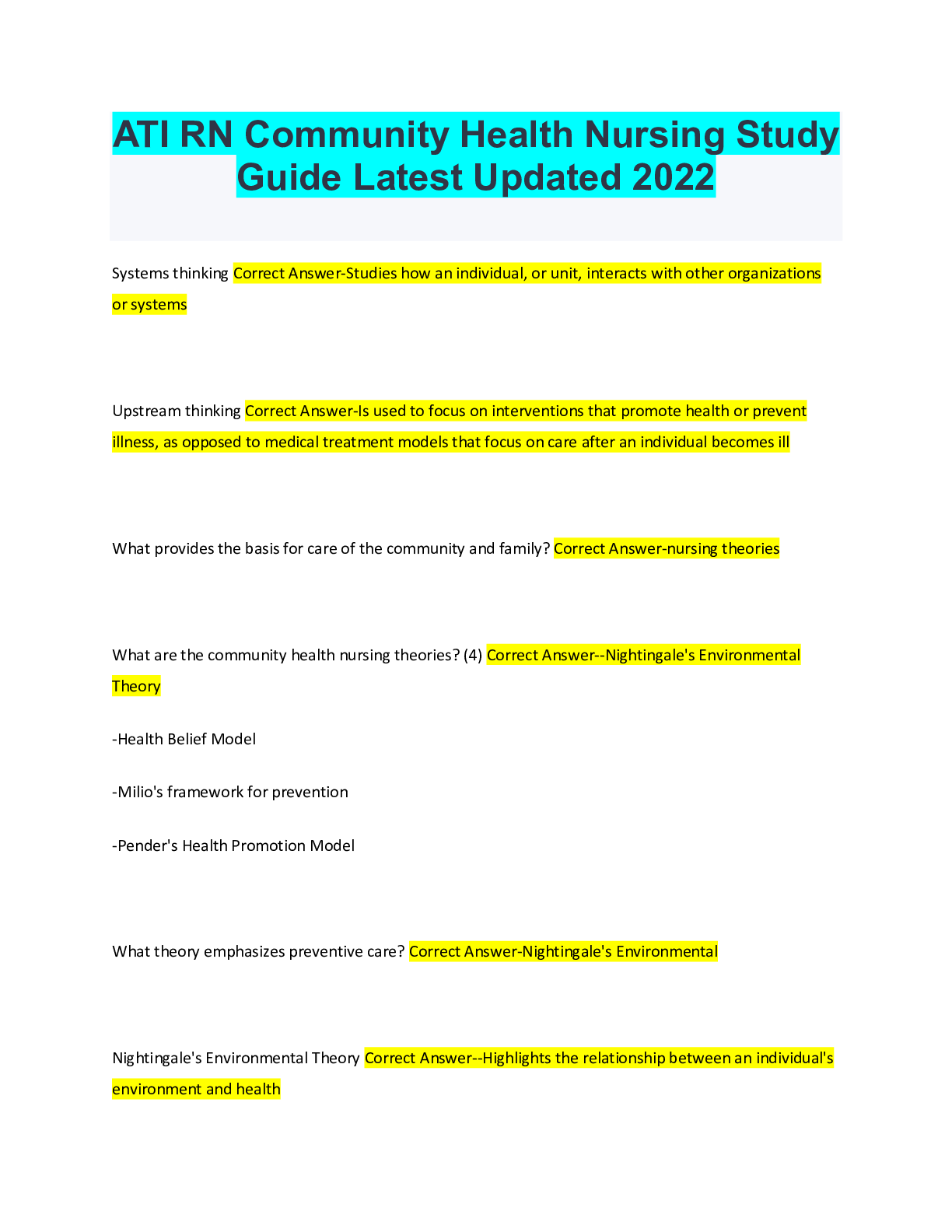
Buy this document to get the full access instantly
Instant Download Access after purchase
Buy NowInstant download
We Accept:

Reviews( 0 )
$9.00
Can't find what you want? Try our AI powered Search
Document information
Connected school, study & course
About the document
Uploaded On
Sep 09, 2022
Number of pages
103
Written in
Seller

Reviews Received
Additional information
This document has been written for:
Uploaded
Sep 09, 2022
Downloads
0
Views
173


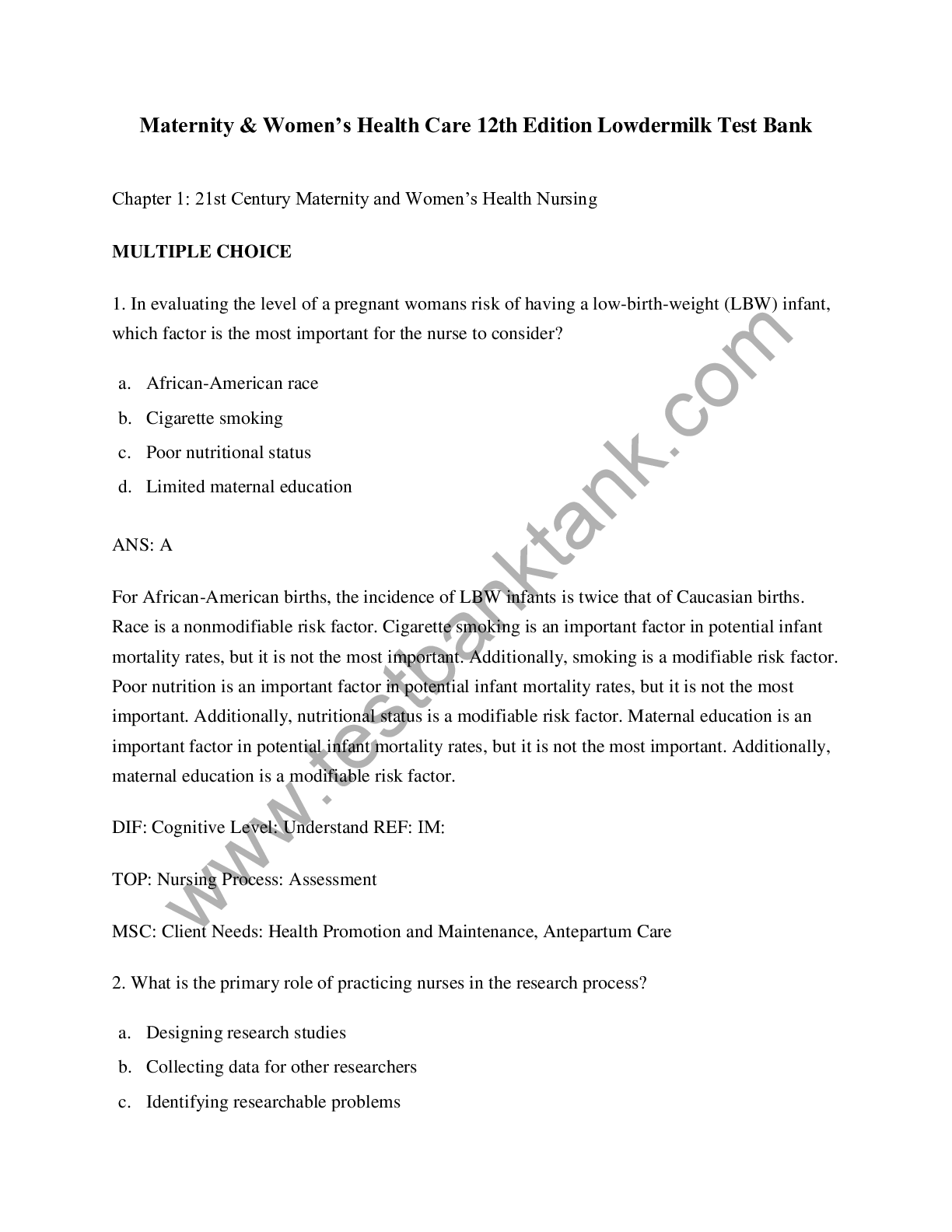









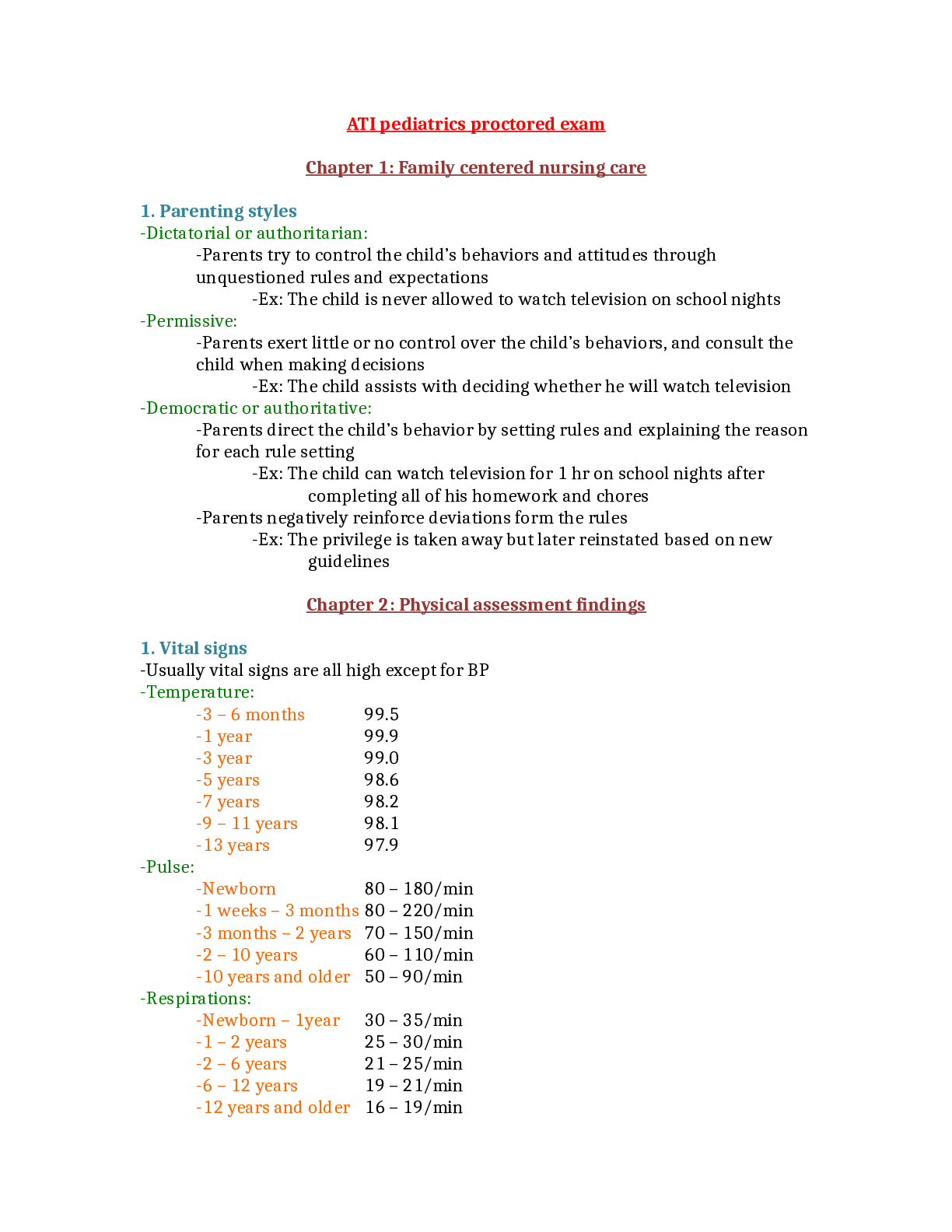




.png)

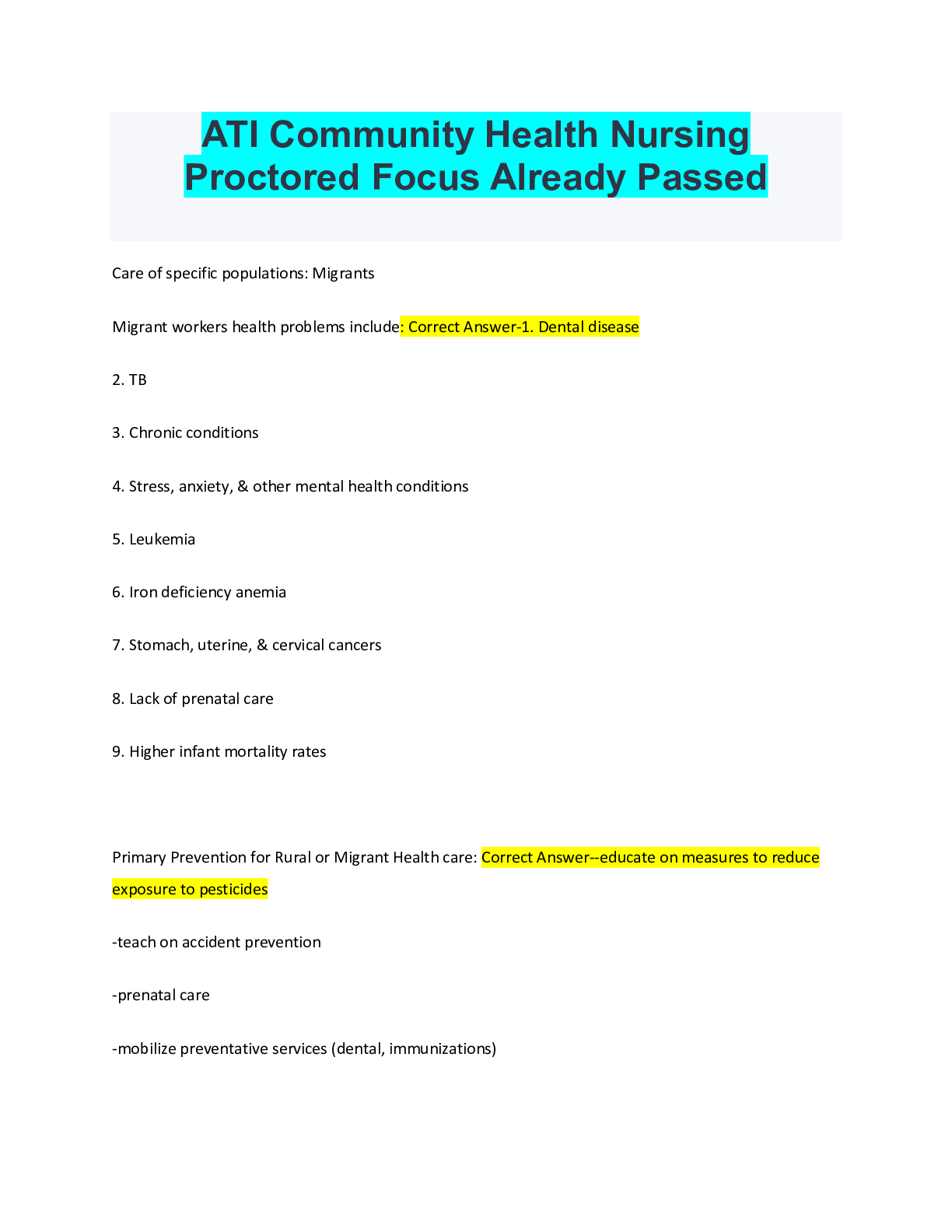
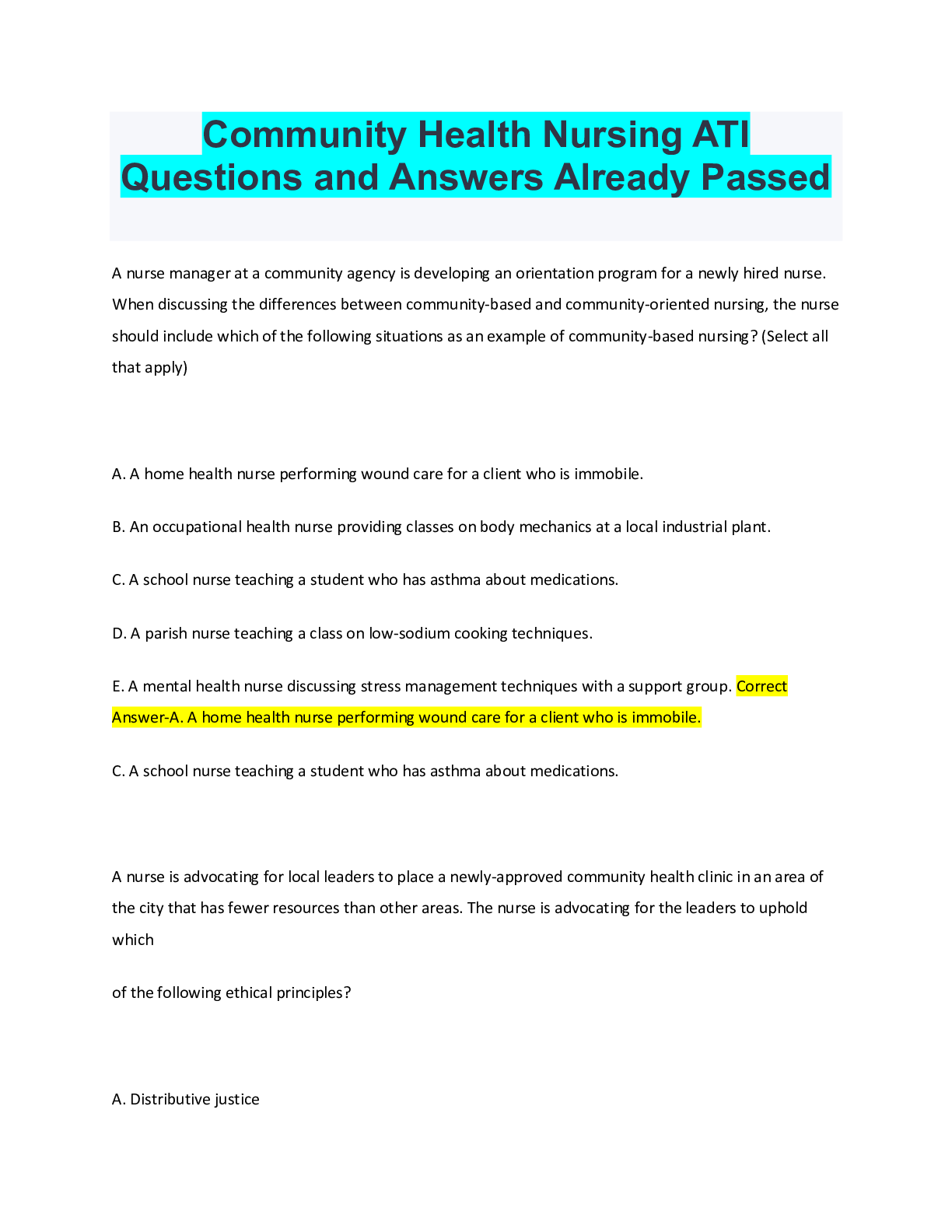

.png)

